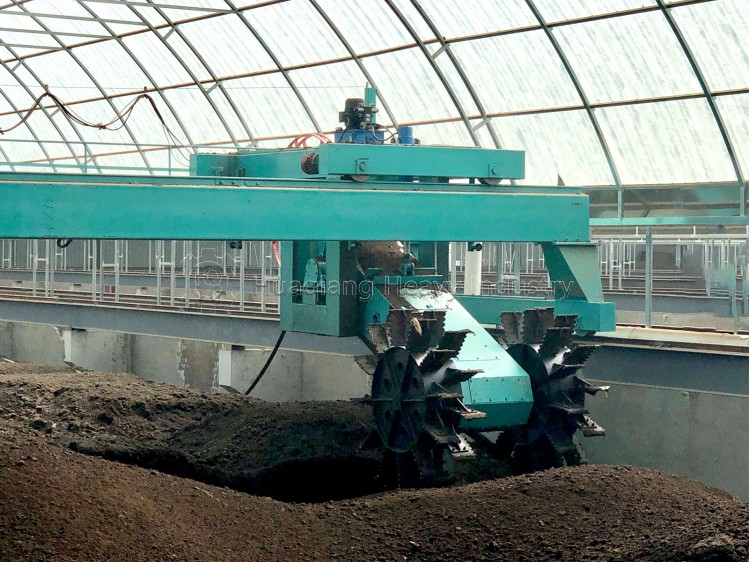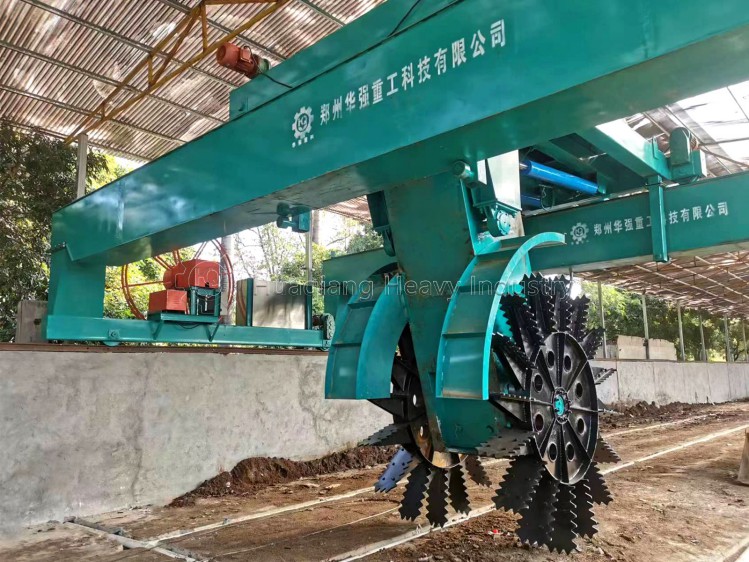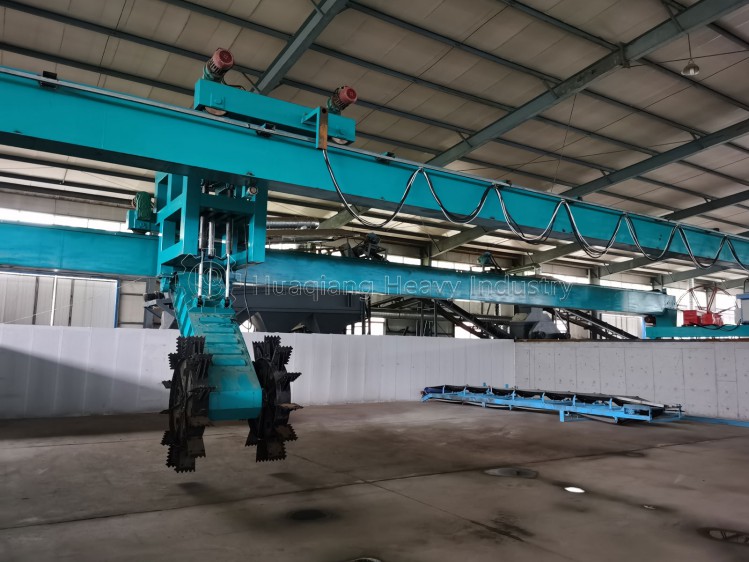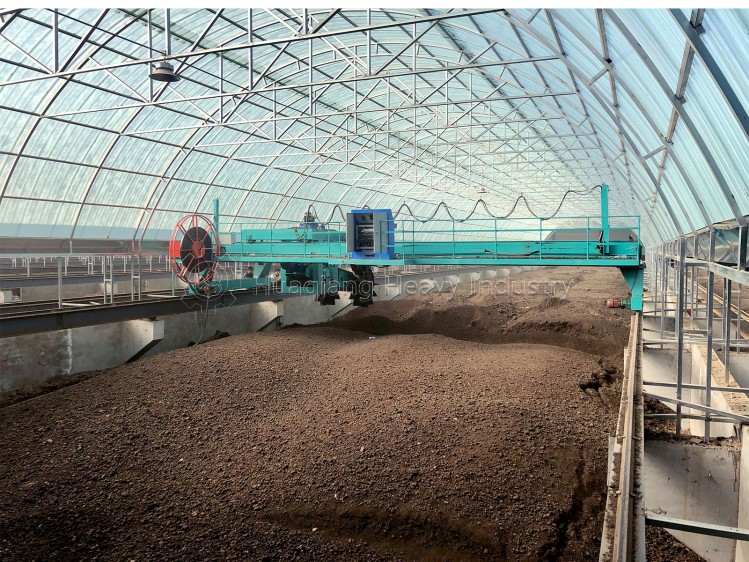




Equipment Overview
A large wheel compost turner is a material fermentation processing equipment based on a large wheel structure. It is primarily used for turning and mixing materials in large-scale organic fertilizer production. Its core operating principle is that the wheel, which can reach several meters in diameter, rotates, driving turning teeth on its edge to turn the accumulated material in a circular motion. Centrifugal force and the turning teeth cause the material to be lifted, dispersed, and re-accumulated, allowing it to fully come into contact with air, regulating its temperature and humidity and accelerating microbial decomposition and ripening.
This equipment utilizes a continuously rotating large wheel design, allowing for wide coverage and high efficiency in a single turning operation. Compared to traditional trough-type or crawler-type compost turners, it is more suitable for large-scale windrow fermentation in organic fertilizer production bases with a capacity of 10,000 tons or more, significantly reducing labor and time costs for large-scale fermentation.
What raw materials can be fermented with a large wheel compost turner?
The large-wheel compost turner, with its powerful turning capacity and processing capacity, can efficiently ferment a variety of large-scale organic raw materials, including the following:
Livestock and poultry manure:This includes large-scale manure such as chicken manure, pig manure, and cow manure produced by large-scale livestock farms. The large-wheel compost turner's powerful turning quickly breaks down compacted layers of manure, kills pathogens, parasite eggs, and weed seeds through high-temperature fermentation, and eliminates odor. Its processing capacity can reach hundreds of tons per day, meeting the manure treatment needs of large-scale livestock farms.
Crop straw:This includes straw from large-scale crop production, such as corn straw, wheat straw, and rice straw. The large-wheel compost turner shreds bundles of straw and evenly mixes it with manure and other materials, promoting the degradation of cellulose and hemicellulose in the straw, converting it into organic matter for organic fertilizer, thereby addressing the environmental pollution caused by straw incineration.
Industrial organic waste:This includes large-scale industrial organic waste such as distiller's grains from alcohol plants, sugar residue from sugar refineries, and medicinal residue from traditional Chinese medicine factories. These materials have a high moisture content and are prone to spoilage. Large-wheel compost turning machines, through continuous turning, can quickly reduce moisture content, promote the growth of beneficial microorganisms, and achieve large-scale resource utilization of industrial waste.
Municipal Sludge:Large quantities of sludge generated by municipal sewage treatment plants can be fermented using large-wheel compost turning machines after heavy metal content testing meets standards. The turning process reduces the sludge's moisture content (from approximately 80% to below 60%), stabilizes its properties, eliminates odors, and transforms it into a safe organic fertilizer.
Garden Waste:Landscape waste, such as fallen branches and leaves, and weeds, generated during urban landscaping, can be mixed with other organic materials and fermented in a large-wheel compost turning machine to produce humus-rich organic fertilizer, thus achieving the recycling of urban landscaping waste. Compost Turner Components
The Compost Turner consists of several key components that work together to ensure efficient turning of large quantities of material.They are as follows:
The main disc is the core working part of the equipment. It is welded from high-strength steel, typically with a diameter of 5-10 meters and evenly distributed turning teeth along its edge. The disc features a hollow design, reducing weight while maintaining structural strength. During operation, it rotates at a speed of 10-20 rpm, using centrifugal force to lift the material.
The turning teeth are made of wear-resistant alloy steel and are distributed spirally or radially along the edge of the disc. They are 30-60 cm long. The turning teeth are bolted to the disc for easy replacement when worn. Their optimized shape allows them to turn and disperse the material from the bottom upward during rotation, ensuring adequate contact with air.
The travel mechanism consists of a drive motor, a reducer, and travel wheels (or tracks), which are responsible for moving the entire equipment around the fermentation site. The travel wheels feature large-diameter, wide tires, resulting in low ground contact pressure and adaptability to soft surfaces. The crawler-type travel mechanism is suitable for more complex terrain, and the travel speed is adjustable via the electronic control system, typically between 0.2 and 1 m/min.
The power system consists of a wheel drive motor and a travel drive motor. The wheel drive motor, with a power of 30-75 kW, rotates the wheel through a speed reducer; the travel drive motor, with a power of 15-30 kW, provides power for machine movement. The power system can be diesel or electric, depending on site conditions, and can be equipped with a large-capacity fuel tank or cable reel.
The support structure consists of a frame and a rotating support. The frame is welded from steel sections and supports the wheel and power system. The rotating support is installed between the wheel and frame and utilizes a large bearing structure to ensure smooth rotation of the wheel and withstand the combined weight of the wheel and material (which can reach tens of tons).
The electronic control system consists of a control cabinet, an operating console, sensors, and actuators. The control panel is equipped with a touchscreen that displays real-time parameters such as the wheel rotation speed, travel speed, and machine operating time. Sensors include a temperature sensor (monitoring fermentation temperature) and a pressure sensor (monitoring wheel load). These sensors automatically generate alarms and shut down the machine for protection when abnormalities such as overload or motor overheating occur.
Auxiliary devices include a sprinkler system, lighting, and a dust cover. The sprinkler system, installed above the wheel, automatically sprays water or a microbial agent based on the moisture content of the material to adjust the humidity. The lighting facilitates nighttime operation, extending the machine's operating time. The dust cover reduces dust raised during turning and reduces environmental pollution.
How does a large wheel compost turner compost organic fertilizer raw materials?
The composting process for organic fertilizer raw materials using a large-scale compost turning machine must be tailored to the specific needs of large-scale operations and follow a continuous fermentation process. The specific steps are as follows:
Raw Material Pretreatment
Bulk organic raw materials are collected and processed centrally: livestock and poultry manure is passed through a solid-liquid separator to remove excess water, reducing the moisture content to below 70%. Straw is crushed to 10-20 cm in length using a pulverizer. Industrial waste is then freed of impurities such as metal and plastic. The raw materials are mixed at a carbon-nitrogen ratio of 25-30:1, and the formula is adjusted by adding straw or manure to achieve a moisture content of 55%-60%.
Wind Stacking
Pretreated raw materials are stacked into large windrows at the composting site. The windrows are 5-8 meters wide and 1.5-2 meters high, with lengths varying depending on production (up to 100 meters). A 3-5 meter walkway is provided between windrows to facilitate movement and operation of the large-scale compost turning machine. Turning and Fermentation
Start the large wheel compost turner and adjust the wheel height to be level with the top of the windrow. The machine moves slowly along the length of the windrow. The wheel rotates at high speed, and the turning teeth toss the material from the bottom upward. Centrifugal force causes the material to disperse to the sides and re-accumulate, ensuring thorough mixing and aeration.
During the initial fermentation period (1-3 days), the first turning of the compost is performed when the temperature reaches 50-60°C. During the high-temperature period (4-10 days), when the temperature reaches 60-70°C, the compost is turned every two days to kill pathogens. During the cooling period (11-25 days), when the temperature drops to 40-50°C, the compost is turned every three to four days to promote humus formation. The entire fermentation cycle is 20-30 days, and a single unit of equipment can turn 500-1000 tons of material per day. Determining Compost Maturity
When the material temperature drops to near ambient temperature (±5°C), the color turns dark brown, the texture becomes loose, there is no noticeable odor, and a light earthy aroma, the material is considered mature. The mature material can be transported to the subsequent processing area by a loader for crushing, screening, and granulation.
How is the large-wheel compost turning machine used in fertilizer production lines?
Large-wheel compost turners are core equipment in the fermentation process of large-scale organic fertilizer production lines. Their applications span the entire raw material fermentation process, specifically as follows:
Linking large-scale raw material processing with further processing
In large-scale fertilizer production lines, pre-treated bulk raw materials (such as livestock and poultry manure and straw) are conveyed by conveyor to the fermentation area, where they are piled into large windrows. Large-wheel compost turners continuously turn and ferment these windrows. The composted materials are then conveyed by conveyor to further processing stages such as crushing and granulation, forming a complete production line encompassing "pretreatment - large-scale fermentation - further processing." Their efficient turning capacity provides a stable supply of raw materials for subsequent processing.
Enabling continuous large-scale fermentation
For organic fertilizer production lines with an annual output of over 100,000 tons, large-wheel compost turners can achieve continuous production by rotating multiple windrows: one windrow receives new material, one performs high-temperature fermentation, and one performs cooler composting. The equipment operates between windrows in a fixed cycle, achieving an average daily processing capacity of 800-1500 tons, meeting the continuous production requirements of the production line. Matching production line capacity and pace
The equipment's compost turning and travel speeds are adjustable via an electronic control system, allowing for flexible adjustments to the fermentation schedule based on the raw material supply rate at the front end and the pelletizer's capacity at the back end. For example, when raw material supply is sufficient, the travel speed can be increased to increase daily processing capacity; when pelletizer capacity increases, the turning cycle can be shortened to accelerate material maturation, ensuring that the fermentation process matches the overall production line pace.
Reducing production line footprint
Large wheel compost turners are suitable for large-scale windrow fermentation. Compared to trough fermentation, they can increase site utilization by over 30%, reducing production line land costs. They are particularly suitable for large production bases with relatively abundant land resources.
| Large Wheel Compost Turning Machine | ||||
| model | Main Motor | Small Car Moving Motor | Big Car Moving Motor | Hydraulic Pump Motor |
| LP-10m | 55KW | 1.5KWX4 | 1.5KWX2(4) | 4KW |
| LP-12m | ||||
| LP-15m | ||||
| LP-20m | ||||